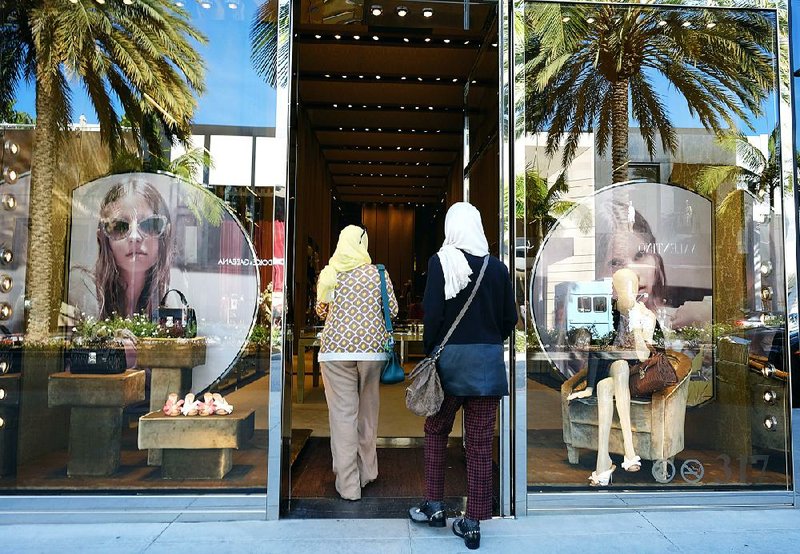WASHINGTON -- Americans increased their spending on autos, furniture, clothing and building materials in March, lifting retail sales for the first time in four months.
Retail sales jumped 0.9 percent last month, after declining 0.5 percent in February, the Commerce Department said Tuesday. The rebound suggests that shoppers are returning after an unseasonably cold winter froze sales.
"If people really held back because of weather, I would have anticipated more spending right away once people get to the mall, once you have a resumption in normal activities," said Laura Rosner, a U.S. economist at BNP Paribas SA in New York. "It does appear that consumers are a little bit more cautious than we would have expected them to be, and that caution is persisting even through the ups and downs in the weather."
Warmer weather fueled a 2.7 percent increase in auto sales and a 2.1 percent increase in building materials, possible signs that the lagging manufacturing and construction sectors might also recover from a winter slump.
Excluding the volatile categories of autos, gas, building materials and restaurants, sales rose 0.3 percent.
Economists say that sales should continue to climb because of the year-long hiring surge and lower gasoline prices.
The unemployment rate has tumbled to 5.5 percent, as the economy has added jobs at a monthly pace of roughly 261,000 during the past year. That amounts to 3.1 million new paychecks to be spent at restaurants, clothiers and elsewhere.
At the same time, gasoline has tumbled to $2.39 a gallon, $1.30 cheaper than a year ago, according to AAA's Daily Fuel Gauge. That should translate into consumers saving an average of $700 compared with 2014, according to government estimates.
The harsh winter curtailed some of the lift provided by lower unemployment rates and gasoline prices. People cut down on visits to malls, auto dealers and open houses, which accompanied a slump in the manufacturing and construction sectors.
But the March sales figure points to stronger months ahead now that winter is in the rearview mirror.
"Together with the continued buildup of cash savings from the drop in gas prices, this suggests to us that we should expect very strong retail sales numbers over the next few months," said Ian Shepherdson, chief economist at Pantheon Macroeconomics.
Higher gas costs drove up wholesale prices last month, ending a string of four straight declines.
The producer price index increased 0.2 percent in March, after sharp drops in the two previous months, the Labor Department said Tuesday. The index measures prices before they reach the consumer.
Excluding the volatile food and energy categories, core prices also rose 0.2 percent.
In the past year, wholesale prices have plummeted 0.8 percent, the sharpest drop in the four years since the government updated its methods for calculating the index. Cheaper gas caused most of the decline. Core prices have risen 0.8 percent in the past 12 months.
If March's increase is sustained, inflation could move closer to levels that the Federal Reserve believes are consistent with a healthy economy. The government reports consumer prices Friday.
Cheaper gas and a strong dollar have kept most measures of inflation at very low levels, and in some cases in negative territory. Gas prices have leveled off in recent months, however, eliminating one source of deflationary pressure. The strong dollar, which makes imports cheaper, will likely continue to keep a lid on inflation, economists say.
"Inflation remains very soft," said Jennifer Lee, an economist at BMO Capital Markets.
U.S. businesses increased their stockpiles by a moderate amount in February although total business sales were weak for a seventh straight month.
Businesses boosted stockpiles 0.3 percent in February after no growth in January, the Commerce Department reported Tuesday. Sales were flat in February after a 2.3 percent plunge in January. Sales by businesses have either fallen or been flat for the past seven months with the most recent increase coming in July.
Economic growth has been slow over the past six months, but economists are looking for a rebound in the current April-June quarter, led by stronger consumer spending. Analysts expect solid job growth will boost incomes, which will translate into stronger spending.
Information for this article was contributed by Josh Boak, Christopher S. Rugaber and Martin Crutsinger of The Associated Press and Michelle Kamrisko of Bloomberg News.
Business on 04/15/2015
